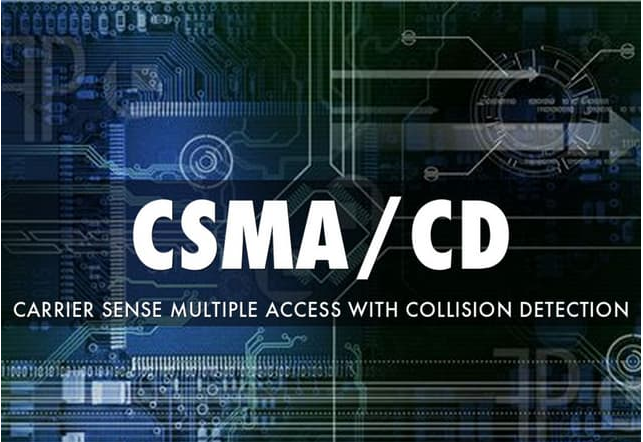What is CSMA/CA? Difference between CSMA/CA and CSMA/CD
CSMA/CA is an access control method for wireless networks that helps optimize data transmission. In this article, we will learn more about CSMA/CA and the differences between it and CSMA/CD.
What is CSMA/CA?
CSMA/CA stands for Carrier Sense Multiple Access/Collision Avoidance which is a protocol used to control access to a network medium. This protocol is mainly applied in wireless networks where multiple devices can share the same communication channel.

CSMA/CA works by requiring stations to check the state of the transmission medium before transmitting data. Stations listen to the transmitters and notify the transmitters when the channel is idle, thus preventing the possibility of collisions when multiple stations share the medium.
How CSMA/CA Works
The CSMA/CA system operates according to a specific procedure to ensure the highest efficiency in data transmission.
- Carrier Sensing: Before starting transmission, the device checks the channel to see if there is a signal transmitting. If there is no signal, the device continues to the next step.
- Collision Avoidance: If the channel is detected to be busy, the device will generate a random time interval to avoid two devices trying to transmit data immediately after the channel becomes free. This helps reduce the chance of collisions.
- Backoff Time: The station selects a random time slot (backoff) value to wait before sending a data frame. If another transmission occurs during the backoff time, the station retains its counter value and continues counting down after the transmission ends, plus a DIFS (distributed interframe space) period. The node can start transmitting when the counter reaches 0.
- Data Transmission and Acknowledgement: When the channel is clear, the station sends its data. The receiver responds with an ACK (acknowledgment) if the data packet is received correctly and completely. If the sender does not receive an ACK, it assumes that a collision has occurred and retransmits the packet.
- RTS/CTS mechanism: CSMA/CA uses Request to Send (RTS) and Clear to Send (CTS) protocols to avoid collisions.
Advantages and disadvantages of CSMA/CA
Like any other technology, CSMA/CA has its own advantages and disadvantages that users need to consider.
Advantage
- Collision Mitigation: By checking the channel before transmitting, it helps to improve network performance and reliability.
- Easy to deploy: CSMA/CA can be easily deployed in existing networks without major infrastructure changes.
- Good for wireless networks: This protocol is well suited for wireless networks, where the number of devices using the same communication channel can increase significantly.
Disadvantages
- Waiting time: Waiting time can be long, especially in crowded environments, when many devices are trying to transmit data.
- Does not completely eliminate collisions: Although CSMA/CA helps reduce collisions, it does not completely eliminate the possibility of collisions. This can lead to data loss in some cases.
- Difficulty in scaling: As the number of connected devices increases, the performance of CSMA/CA may degrade due to longer waiting times.
CSMA/CA over the Internet
The Internet environment is becoming increasingly large and complex. CSMA/CA plays an important role in maintaining the quality of service of wireless networks in this context.

CSMA/CA over the Internet
Impact on transmission speed
In a large wireless network, transmission rates can be affected by many factors, including the number of active devices. CSMA/CA helps regulate this rate by allocating a reasonable waiting time to each device.
Traffic Management
With the rise of the Internet of Things (IoT), the number of devices connected to wireless networks is increasing. CSMA/CA helps manage this traffic efficiently, ensuring that all devices have the opportunity to transmit data without degrading the overall performance of the network.
Interaction with other protocols
In the Internet environment, CSMA/CA often interacts with other protocols such as TCP/IP. The integration of these protocols helps optimize the data transmission process, thereby improving the user experience.
Comparison of wired network with CSMA/CA wireless network
Wired and wireless networks both have their own advantages and disadvantages. However, when compared with CSMA/CA, we can clearly see the differences.
Difference between CSMA/CA and CSMA/CD
Both CSMA/CA and CSMA/CD are access control protocols, but they work in very different ways.
Conclude
CSMA/CA has proven its value and role in optimizing data transmission. Although there are some disadvantages, the ability to minimize collisions and ease of implementation have made CSMA/CA a top choice for today's wireless networks.
Understanding the difference between CSMA/CA and CSMA/CD not only helps us better understand how networks work, but also aids in designing and implementing network systems that are suitable for future usage needs.
You should read it
- 17 invaluable lessons that love has taught us
- How to cancel a print job on Word, Excel
- Mozilla officially launched Firefox 25
- How to change the voice search language to Vietnamese in Google Maps on iPhone / iPad
- Relax with 3 ways to print in this simple reverse order
- Fix the Unmountable Boot Volume error on Windows 10
 What is DNS 8.8.8.8? How to change DNS 8.8 8.8 on Windows, MacOS and Android
What is DNS 8.8.8.8? How to change DNS 8.8 8.8 on Windows, MacOS and Android What is Spanning Tree? Benefits of Spanning Tree Protocol?
What is Spanning Tree? Benefits of Spanning Tree Protocol? What is PSTN? Comparison between PSTN and VoIP
What is PSTN? Comparison between PSTN and VoIP What is SRV Record? Structure and how to create SRV Record
What is SRV Record? Structure and how to create SRV Record What is Uptime Tier? International Standard Data Assessment Levels
What is Uptime Tier? International Standard Data Assessment Levels What is ANN? Applications of Artificial Neural Network
What is ANN? Applications of Artificial Neural Network